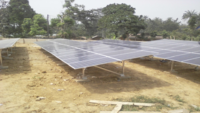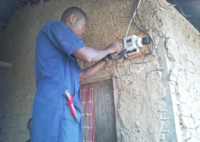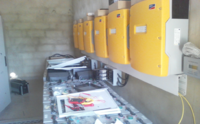Solar Mini Grid Facility in Umon Island and Bagana Community in Nigeria
Introduction
In Nigeria, about 50% of the population (estimated to be about 191 million people) are not connected to the national electricity grid and majority of these people are located in the rural areas. Umon Island and Bagana Community, both located in Biase Local Government Area of Cross River State, southern Nigeria are among the numerous communities in Nigeria that are connected to the national electricity grid. The two communities are located in extremely difficult terrain that makes them very unattractive for grid extension. They are surrounded by the water of River Cross. The main access route from Calabar, the capital of Cross River State, require going up north for about two hours and then going through River Cross on speed boat for a period of about 30 minutes depending on the depth of the water. Until this time, the community members rely on traditional energy sources such as candles and kerosene lantern for lighting. Those that can afford it, generate electricity from the privately-owned petrol or diesel generator.
Solar Mini-grid Project
The Project Team in the company of the Local Government Chairman, Hon. Enebieni Ana visited Umon Island for the first time in November 2016. In that visit, the Team stated their intention to build a 50kW photovoltaic system that will supply electricity to the two communities. The Community Research and Development Centre (CREDC) is serving as the Project Developer and the Operator of the system and was supported by the Nigeria Energy Support Programme of GIZ and the European Union. During the early activities in the Community, members were skeptical and wondering if this promise will ever come to pass. This doubt probably stemmed from previous promises made to them which never materialized. There is a popular say that “Action speaks louder than voices”.
In March 2017, the Village Power Committee (VPC) was inaugurated. The VPC is a five-man committee comprising 3 men and 2 women all members of the two communities. The VPC serves as an interface between the Project Developer and members of the communities. The load assessment study was carried out to gather sufficient baseline information to develop the project and help in the operation of the facility. The study revealed that the people of Umon Island and Bagana Community were already familiar with electricity as an estimated 80% of the households have private generators. The memorandum of understanding (MOU) between the Communities and the Project Developer was signed in May 2017. As a way of preparing the communities ahead of the commissioning of the mini grid, two workshops were organized at Umon Island to educate the community on energy efficiency and conservation, safety tips on using electricity and on the productive use of electricity.
Then, the installation of the grid facility began; a total of one hundred and six (106) high quality, wooden electric poles were mounted across the two communities. Each pole was erected 4ft below the ground level with concrete cast to hold the poles firmly to the ground. The grid cables consist of insulated aluminium cables. The “transmission” lines are made of three-phase cables that convey power from the power station to different points in the communities and the “distribution” lines ran from these points to individual houses. Before connecting each household, the Project Developer signed end-users’ contract with each beneficiary. A total of ninety-one (91) households representing about 50% of the total customers have been connected as at the time of this report. Each customer was given single-phase prepaid meters with IC card to top up when the credit is exhausted.
The generation assets were installed - the solar arrays were installed in their positions, likewise the inverters and the batteries. The people of Umon Island and Bagana Communities now enjoy electricity just like those living in big cities. The electricity is not free; the tariff was determined using a financial modeling tool. The preliminary study in the communities revealed that members are willing and able to pay for the electricity (70% spend about N15,000 monthly to buy fuel for their generators). We are optimistic that the solar mini grid will help to eliminate the use of private generators in the two communities and at the same time increase economic activities in the two communities.
Further Information
Reference
- This article is written by *****






















